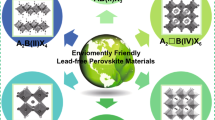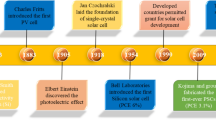Abstract
Semiconducting KTaO3 single crystals were investigated as a model potential photoanode for hydrogen production using photoelectrochemical cells. To modify the electronic properties of KTaO3 by reducing the band gap and thereby increasing the absorption of light at longer wavelengths, the crystals were doped during growth. A wide range of dopant elements was used that consisted primarily of transition metal atoms. Most of the crystals exhibited n-type behavior with carrier concentrations from 4 × 1018 to 2.6 × 1020 cm–3. The position of the band edges indicated that the crystals were thermodynamically capable of water dissociation. External quantum yield measurements revealed that the samples were photoactive up to a wavelength of ~350 nm. The indirect band gap and a parameter denoted as E1 that is related to the direct band edge of the semiconductor, were found to be essentially the same for all of the samples. These results indicate that the various dopants and treatments did not produce changes in the KTaO3 electronic structure that were sufficient to significantly modify the behavior of KTaO3 in a PEC cell.
Similar content being viewed by others
References
I.E. Paulauskas, J.E. Katz, G.E. Jellison Jr., N.S. Lewis, L.A. Boatner Growth, characterization, and electrochemical properties of doped n-type KTaO3 photoanodes. J. Electrochem. Soc. 156, B580 (2009)
G.E. Jellison Jr., I. Paulauskas, L.A. Boatner, D.J. Singh Optical functions of KTaO3 as determined by spectroscopic ellipsometry and comparison with band-structure calculations. Phys. Rev. B 74, 155130 (2006)
T. Bak, J. Nowotny, M. Rekas, C.C. Sorrel Photo-electrochemical hydrogen generation from water using solar energy: Materials-related aspects. Int. J. Hydrogen Energy 27, 991 (2002)
K. Rajeshwar Hydrogen generation at irradiated oxide semiconductor-solution interfaces. J. Appl. Electrochem. 37, 765 (2007)
M.X. Tan, P.E. Laibinis, S.T. Nguyen, J.M. Kesselman, C.E. Stanton, N.S. Lewis Principles and Applications of Semiconductor Photoelectrochemistry edited by K.D. Karlin Vol. 41 Progress in Inorganic Chemistry (John Wiley & Sons, New York 1994)
A. Fujishima, K. Honda Electrochemical photolysis of water at a semiconductor electrode. Nature 238, 37 (1972)
X.Y. Li, P.L. Yue, C. Kutal Synthesis and photocatalytic oxidation properties of iron doped titanium dioxide nanosemiconductor particles. New J. Chem. 27, 1264 (2003)
E. Piera, Tejedor-M.I. Tejedor, M.E. Zorn, M.A. Anderson Relationship concerning the nature and concentration of Fe(III) species on the surface of TiO2 particles and photocatalytic activity of the catalyst. Appl. Catal., B 46, 671 (2003)
S.X. Wu, Z. Ma, Y.N. Qin, F. He, L.S. Jia, Y.J. Khang XPS study of copper doping TiO2 photocatalyst. Acta Phys. Chim. Sin. 19, 967 (2003)
D. Dvoranova, V. Brezova, M. Mazur, M.A. Malati Investigations of metal-doped titanium dioxide photocatalysts. Appl. Catal., B 37, 91 (2002)
S.T. Martin, C.L. Morrison, M.R. Hoffmann Photochemical mechanism of size-quantized vanadium-doped TiO2 particles. J. Phys. Chem. 98, 13695 (1994)
S.H. Wemple Some transport properties of oxygen-deficient single-crystal potassium tantalate (KTaO3). Phys. Rev. 137, 1575 (1965)
L.S. Senhouse, M.V. Depaolis, T.C. Loomis Calcium concentration vs. net ionized donor concentration in single-crystal KTaO3. Appl. Phys. Lett. 8, 173 (1966)
D.M. Hannon Electron paramagnetic resonance of Fe3+ and Ni3+ in KTaO3. Phys. Rev. 164, 366 (1967)
M.M. Abraham, L.A. Boatner, D.N. Olson, U.T. Höchli EPR studies of some fn and dn electronic impurities in KTaO3 single-crystals. J. Chem. Phys. 81, 2528 (1984)
D.M. Hannon Electron paramagnetic resonance of Mn2+ in KTaO3. Phys. Rev. B: Condens. Matter 3, 2153 (1971)
I.N. Geifman Electron-paramagnetic resonance of Ti3+ in KTaO3. Phys. Status Solidi B 85, K5 (1978)
A.J. Bard, L.R. Faulkner Electrochemical Methods: Fundamentals and Applications 2nd ed (John Wiley & Sons, New York 2001) 369
S. Aravazhi, A. Tapponnier, D. Gunther, P. Gunter Growth and characterization of barium-doped potassium tantalate crystals. J. Cryst. Growth 282, 66 (2005)
A.W. Bott Electrochemistry of semiconductors. Curr. Sep. 13, 87 (1998)
P.J. Boddy, D. Kahng, Y.S. Chen Oxygen evolution on potassium tantalate anodes. Electrochim. Acta 13, 1311 (1968)
I.E. Paulauskas, J.E. Katz, G.E. Jellison Jr., N.S. Lewis, L.A. Boatner Photoelectrochemical studies of semiconducting photoanodes for hydrogen production via water dissociation. Thin Solid Films 516, 8175 (2008)
Author information
Authors and Affiliations
Corresponding author
Rights and permissions
About this article
Cite this article
Paulauskas, I.E., Jellison, G.E. & Boatner, L.A. Photoelectrochemical properties of n-type KTaO3 single crystals in alkaline electrolytes. Journal of Materials Research 25, 52–62 (2010). https://doi.org/10.1557/JMR.2010.0001
Received:
Accepted:
Published:
Issue Date:
DOI: https://doi.org/10.1557/JMR.2010.0001




